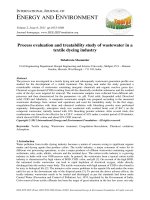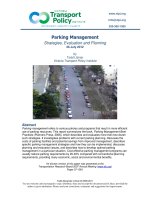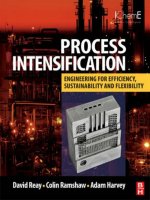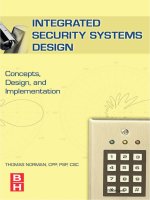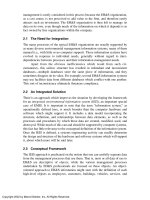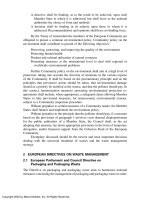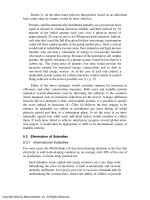Sustainable process engineering concepts, strategies, evaluation, and implementation pan stanford (2013)
Bạn đang xem bản rút gọn của tài liệu. Xem và tải ngay bản đầy đủ của tài liệu tại đây (4.18 MB, 417 trang )
This page intentionally left blank
CRC Press
Taylor & Francis Group
6000 Broken Sound Parkway NW, Suite 300
Boca Raton, FL 33487-2742
© 2012 by Taylor & Francis Group, LLC
CRC Press is an imprint of Taylor & Francis Group, an Informa business
No claim to original U.S. Government works
Version Date: 2012912
International Standard Book Number-13: 978-9-81436-422-5 (eBook - PDF)
This book contains information obtained from authentic and highly regarded sources. Reasonable efforts have been made to publish reliable data and information, but the author and publisher
cannot assume responsibility for the validity of all materials or the consequences of their use. The
authors and publishers have attempted to trace the copyright holders of all material reproduced in
this publication and apologize to copyright holders if permission to publish in this form has not
been obtained. If any copyright material has not been acknowledged please write and let us know so
we may rectify in any future reprint.
Except as permitted under U.S. Copyright Law, no part of this book may be reprinted, reproduced,
transmitted, or utilized in any form by any electronic, mechanical, or other means, now known or
hereafter invented, including photocopying, microfilming, and recording, or in any information
storage or retrieval system, without written permission from the publishers.
For permission to photocopy or use material electronically from this work, please access www.
copyright.com ( or contact the Copyright Clearance Center, Inc.
(CCC), 222 Rosewood Drive, Danvers, MA 01923, 978-750-8400. CCC is a not-for-profit organization that provides licenses and registration for a variety of users. For organizations that have been
granted a photocopy license by the CCC, a separate system of payment has been arranged.
Trademark Notice: Product or corporate names may be trademarks or registered trademarks, and
are used only for identification and explanation without intent to infringe.
Visit the Taylor & Francis Web site at
and the CRC Press Web site at
August 27, 2012
15:33
PSP Book - 9in x 6in
00-David-Brennan–prelims
Contents
xvii
xix
Acknowledgements
Preface
PART A: CONCEPTS
Introduction to Part A
3
1 Sustainability Concepts
1.1 The Concept of Sustainable Development
1.2 Sustainability in the Context of the Process Industries
1.3 Some Temporal Characteristics of Sustainability
1.3.1 Time Horizons in Project Evaluation
1.3.2 Time Horizons for Technology Development
1.3.3 Time Dependence of Technology Improvement
1.3.4 Robustness to Technological, Economic, and
Regulatory Change
1.3.5 Appraisal of Uncertainties (Technical, Business, and
Environmental)
1.4 The Sustainable Project or Industry
1.5 Conflicts in Achieving Sustainability Objectives
9
9
13
14
14
14
14
15
15
16
2 Cleaner Production
2.1 Introduction
2.2 The Concept of ‘Cleaner Production’
2.3 The Product Life Cycle
2.4 Hierarchy of Waste Management
2.5 Concepts and Sources of Waste
2.5.1 Concepts of Waste
2.5.2 Process and Utility Waste
2.5.3 Utility Waste and System Boundary Definition
2.5.4 Packaging
19
19
19
20
23
24
24
24
25
27
15
August 27, 2012
vi
15:33
PSP Book - 9in x 6in
00-David-Brennan–prelims
Contents
2.6 Impacts of Waste
2.7 Classification of Waste
2.8 Driving Forces for Cleaner Production
2.9 Resistances to Introducing Cleaner Production
2.10 Concluding Remarks
3 Industrial Ecology
3.1 The Basic Concept of Industrial Ecology
3.2 Energy and Materials Recovery from Waste Streams
3.3 Resource Flow through the Economy
3.3.1 Sulphur Flow in Australia
3.4 Transport and Storage of Raw Materials and Products
3.4.1 Marine Transport
3.4.2 Road and Rail Transport
3.5 Integrated Site Manufacture
3.6 Some Examples of Industrial Ecology Initiatives
3.6.1 Case 1: Hydrogen Utilisation from Refineries
3.6.2 Case 2: Fertiliser Complex, Queensland, Australia
3.6.3 Case 3: Industrial Integration at Kalundborg, Denmark
3.6.4 Case 4: Industrial Symbiosis at Kwinana, Western
Australia
3.7 Concluding Remarks
Problems: Part A
27
27
28
28
29
31
31
34
34
34
35
36
36
36
38
38
39
40
41
42
45
PART B: STRATEGIES
Introduction to Part B
4 Waste Minimisation in Reactors
4.1 Introduction
4.2 A Checklist for Reaction Systems and Reactors
4.3 Chemistry of Process Route
4.3.1 Conversion, Selectivity, and Yield
4.3.2 Co-Product and By-Product Utilisation
4.4 Impurities in Reactor Feedstocks
4.5 Mixing of Reactants
4.5.1 Mixing of Gaseous Reactants
4.5.2 Mixing of Liquids
4.5.3 Fluid Distribution in Packed Bed Reactors
53
55
55
56
57
59
60
60
62
62
62
62
August 27, 2012
15:33
PSP Book - 9in x 6in
00-David-Brennan–prelims
Contents
4.6
4.7
4.8
4.9
Minimising Secondary Reactions
Recycle of Unreacted Feed from Reactor Outlet
Reversible Reactions
Catalysis
4.9.1 Example of the Effect of Catalyst Activity on
Performance
4.10 Agent Materials
4.11 Case Examples
4.12 Chlor-Alkali Production in Mercury Cell
4.12.1 Transport Paths
4.12.2 Other Aspects of the Mercury Cell Chlorine
Process
4.13 Ethylene Manufacture from Hydrocarbons
4.14 Hydrogen Cyanide Manufacture from Ammonia, Methane,
and Air
4.15 Sulphuric Acid Manufacture
4.16 PVC Production by Suspension Polymerisation of Vinyl
Chloride Monomer
4.17 Concluding Remarks
5 Waste Minimisation in Separation Processes
5.1 Classification of Separation Processes
5.2 Sources of Waste in Separation Processes
5.3 Distillation
5.4 Gas Absorption
5.5 Adsorption
5.6 Filtration
5.6.1 Centrifugal Separation
5.6.2 Filtration of Solids from Gas Streams
5.6.3 Separation of Liquid Particulates from Gas
Streams
5.7 Drying
5.8 Evaporation and Condensation
5.9 Solid–Liquid Extraction
5.10 Liquid–Liquid Extraction
5.11 Use of Extraneous Materials
5.11.1 Example of Extraneous Material Use — Sulphuric Acid
in Chlorine Drying
5.12 Case Examples
5.12.1 Case Example — Solid Sodium Cyanide Plant
63
64
64
65
66
67
67
68
69
71
71
73
75
78
80
83
83
84
85
87
90
91
92
92
92
93
93
94
95
95
96
97
98
vii
August 27, 2012
15:33
PSP Book - 9in x 6in
00-David-Brennan–prelims
viii Contents
5.12.2 Other Case Examples of Gas Absorption in Chemical
Processes
5.12.3 Case Examples in Distillation
5.13 Concluding Remarks
99
100
101
6 Identification of Waste in Utility Systems
6.1 Introduction
6.2 Fuels
6.3 Fuel Combustion
6.3.1 Heat of Combustion
6.3.2 Excess Air
6.4 Common Fuels
6.5 Environmental Impacts of Flue Gases
6.5.1 NOx Formation in Fuel Combustion
6.6 Theoretical Flame Temperatures
6.7 Furnaces
6.8 Flare Stacks
6.9 Steam Generation
6.10 Steam Use
6.11 Water Sources and Uses
6.11.1 Water Quality Indicators
6.12 Recirculated Cooling Water from Cooling Towers
6.13 Sea Water Cooling
6.14 Air Cooling
6.15 Refrigeration
6.16 Electricity Demand and Supply
6.17 Distribution and Use of Electricity
6.18 Compressed Air
6.19 Inert Gas
6.20 Vacuum
6.21 Concluding Remarks
103
103
105
105
106
107
107
109
110
111
111
112
113
116
119
120
121
123
124
124
126
129
130
130
131
131
7 Energy Conservation
7.1 Introduction
7.2 Energy Consumption in Compression of Gases
7.2.1 Process Specification for Gas Compressors
7.2.2 Machine Selection
7.2.3 Thermodynamics of Gas Compression
7.2.4 Limits to Compression Ratio per Stage of Compression
7.2.5 Intercooling of Gas during Compression
133
133
134
134
134
136
138
138
August 27, 2012
15:33
PSP Book - 9in x 6in
00-David-Brennan–prelims
Contents
7.2.6 Reliability
7.2.7 Drives for Compressors
7.2.8 Energy Conservation in Gas Compression
7.3 Energy Consumption in Pumping of Liquids
7.3.1 Process Specification for Pumps
7.3.2 Power Requirement
7.3.3 Pump Machine Types
7.3.4 Centrifugal Pump Selection and Performance
7.3.5 Energy Conservation in Pumping of Liquids
7.4 Pressure Losses in Piping
7.4.1 Sizing of Pipes
7.5 Pressure Loss through Equipment
7.5.1 Heat Exchangers
7.5.2 Vapour–Liquid Contacting Columns
7.6 Agitation and Mixing
7.7 Heat Recovery
7.8 Energy Recovery from High Pressure Streams
7.9 Insulation
7.10 Plant Layout
7.11 Concluding Remarks
8 Materials Recycling
8.1 Introduction
8.2 Recycling of Materials in Chemical Processes
8.2.1 Economics of Recycling Process Streams
8.2.2 Environmental Credits and Burdens of Recycling
8.3 Closed Loop and Open Loop Recycling
8.4 On-Site and Off-Site Recycling
8.4.1 Examples of Off-Site Recycling
8.5 Producer and Consumer Waste
8.6 Hierarchical Approach to Materials Recycling
8.7 Plastics Recycling
8.8 Glass Recycling
8.9 Recycling of Materials from Products
8.10 Waste Treatment Option
8.11 Aqueous Effluent Treatment and Water Recycling
8.12 Disposal of Wastes
8.12.1 Landfill
8.12.2 Incineration
8.13 Concluding Remarks
138
139
139
139
139
141
141
142
144
144
144
145
145
146
147
149
150
150
151
151
155
155
155
156
156
157
159
159
159
160
161
163
164
164
165
167
167
168
169
ix
August 27, 2012
15:33
PSP Book - 9in x 6in
00-David-Brennan–prelims
x Contents
9 Waste Minimisation in Operations
9.1 Non-Flow-Sheet Emissions from a Process Plant
9.2 Plant Start-Up
9.2.1 Case Example — Starting Up a Sulphuric Acid Plant
9.3 Shut-Down of a Plant
9.4 Abnormal Operation
9.5 Plant Maintenance
9.6 Cleaning of Plant and Equipment
9.7 Fouling
9.8 Transport and Storage of Raw Materials and Products
9.8.1 Storage Tanks
9.8.2 Major Environmental Incidents Arising from Storage
9.9 Fugitive Emissions
9.10 Environmental Risks Resulting from Storm Water
9.11 Risks in Mining and Extraction of Materials
9.12 Concluding Remarks
Problems: Part B
171
171
172
172
173
173
174
175
175
176
177
178
179
180
180
181
183
PART C: EVALUATION
10 Life Cycle Assessment
10.1 Introduction
10.2 Product and Process Applications
10.3 Basic Steps in Life Cycle Assessment
10.4 Goal Definition
10.4.1 Example of System Boundary Determination
10.5 Inventory Analysis
10.5.1 Treatment of Utilities and Energy
10.5.2 Allocation Procedures
10.6 Example of Inventory Data Estimation
10.7 Classification
10.7.1 Further Discussion of Impact Categories
10.7.2 Assignment and Weighting of Chemical Compounds
10.7.3 Normalisation
10.8 Improvement Analysis
10.9 Some Challenges and Uncertainties in LCA
10.9.1 Goal Definition
10.9.2 Inventory Data
193
193
194
196
197
198
201
202
202
203
205
206
210
215
215
217
217
217
August 27, 2012
15:33
PSP Book - 9in x 6in
00-David-Brennan–prelims
Contents
10.9.3 By-Products — Marketable or Waste?
10.9.4 Impact Analysis
10.9.5 Resource Depletion
10.9.6 Normalisation
10.9.7 Valuation
10.10 Some Alternative or Supplementary Approaches to LCA
10.10.1 EPS System — An Example of Evaluation Used
with Inventory Data
10.10.2 Eco-Indicator
10.11 LCA Software
10.12 Concluding Remarks
11 Life Cycle Assessment Case Studies
11.1 Introduction
11.2 Life Cycle Inventories for Common Utilities
11.2.1 Assumptions by Golonka and Burgess Regarding
Utility Systems
11.2.2 Derived Inventory Data
11.3 Inventory Data for Distinct Electricity Supply Systems
11.4 Hydrotreating of Diesel
11.4.1 Hydrotreating Process
11.4.2 System Boundary
11.4.3 Inventory Data
11.4.4 Impact Assessment
11.4.5 Environmental Burden versus Benefit Comparison
11.4.6 Conclusions
219
219
220
221
222
224
224
225
225
225
229
229
229
230
231
231
233
233
233
235
239
242
243
12 Safety Evaluation
247
12.1 Introduction
247
12.2 Importance of Learning from Accidents, Dangerous
Occurrences
249
12.3 Life Cycle Issues
251
12.4 Health, Safety, and the Environment
252
12.5 Examples of Safety Incidents in the Process Industries
Involving Environmental Damage
253
12.6 Accident Prevention
255
12.6.1 The HAZOP Approach
255
12.7 Techniques for Investigating Probability of Major Incidents 256
12.8 Risk Assessment
257
xi
August 27, 2012
xii
15:33
PSP Book - 9in x 6in
00-David-Brennan–prelims
Contents
12.9 Preventive Approaches
12.10 Transport and Storage of Chemicals
12.11 Government Legislation
12.12 Concluding Remarks
258
259
260
261
13 Assessment of Costs and Economics
13.1 Introduction
13.2 Investment Projects
13.3 Capital Requirements and Sources
13.4 Fixed Capital Costs
13.4.1 Approximate Estimates of Plant
13.4.2 Equipment Costs
13.4.3 Contributions to Plant Costs
13.4.4 Estimating Fixed Capital Costs of Plants
13.5 Working Capital Costs
13.6 Operating Costs
13.6.1 Simplified Cost Model
13.6.2 Classification of Production Costs
13.6.3 Estimation of Production Costs
13.6.4 Depreciation
13.6.5 Capital Recovery
13.6.6 Worked Example: Cost of Utilities Generation
13.6.7 Environmental Management-Related Costs
13.6.8 Cost Sheet Summary
13.7 Revenue or Benefits Estimation
13.8 Engineering for a Movable Target
13.9 Profitability
13.10 Case Example
13.11 Economies of Scale
13.11.1 Case Example in Scale Economies
13.12 Environmental Externalities
13.12.1 Estimating External Environmental Costs
13.12.2 Emission Taxes and Emission Trading Schemes
13.13 Life Cycle Costs of Projects
13.14 Conclusions
265
265
266
267
268
268
270
271
271
273
274
274
275
275
276
276
277
278
278
280
281
282
284
289
290
291
292
293
293
294
14 Sustainability Assessment
14.1 Introduction
14.2 Common Threads in Enviro-Economic Assessment
297
297
297
August 27, 2012
15:33
PSP Book - 9in x 6in
00-David-Brennan–prelims
Contents
14.3 Cost Benefit Approach to Enviro-Economic
Assessment
14.4 Quantifying Benefits and Burdens
14.5 Case Examples in Enviro-Economic Assessment
14.5.1 Case 1: Sulphuric Acid Manufacture
14.5.2 Case 2: Product Improvement through
Hydrotreating of Diesel
14.5.3 Case 3: Power Generation from Fossil Fuels:
CCGT-NG versus ST-Br Coal
14.6 Environmental Effects of Scale of Production
14.7 Sustainability Assessment and Sustainability Metrics
14.7.1 Case Study on Sustainability of Electricity
Generation
14.8 Perception and Assessment of Risk
14.9 Scenario Analysis
14.10 Concluding Remarks
309
310
313
313
Problems: Part C
315
299
300
300
300
302
304
307
308
PART D: IMPLEMENTATION
15 Planning for Sustainable Process Industries
15.1 Introduction
15.2 Forecasting
15.3 Scenario Development
15.4 Technology Innovation
15.4.1 Intensification
15.4.2 Technology Diffusion
15.4.3 Technology Evolution
15.4.4 Rates of Change
15.5 Transition to Renewable Feedstocks
15.6 Site Selection for Process Plants
15.7 Integration of Process Plants and Process Industries
15.8 Distributed Manufacture
15.8.1 Case of Aqueous Sodium Cyanide Production at
the Point of Use
15.9 Government Legislation
15.10 Stakeholder Engagement
15.11 Lifestyle Implications
325
325
325
326
327
327
328
328
329
329
331
333
334
335
340
341
341
xiii
August 27, 2012
xiv
15:33
PSP Book - 9in x 6in
00-David-Brennan–prelims
Contents
16 Process Design and Project Development
16.1 Introduction
16.2 The Design Process
16.3 Process Flow Sheet Development
16.3.1 Defining the Need
16.3.2 Creating Plausible Solutions
16.3.3 Screening of Alternatives
16.3.4 Further Evaluation of Selected Options
16.3.5 Optimisation and Scrutiny of Final Solution
16.4 Criteria for Process Flow Sheet Evaluation
16.4.1 Technical Feasibility
16.4.2 Capital Cost
16.4.3 Operating Costs
16.4.4 Safety
16.4.5 Environmental
16.4.6 Sustainability
16.4.7 Reliability
16.4.8 Operability
16.5 Process Flow Sheet Documentation
16.6 Piping and Instrumentation Diagram
16.7 Project Development
16.8 Acceptability Criteria for Projects
16.8.1 Technical Requirements
16.8.2 Economic Viability
16.8.3 Safety
16.8.4 Environmental
16.8.5 Sustainability
16.9 Integrating Criteria Assessments
16.10 Concluding Remarks
345
345
345
349
349
349
350
350
350
351
351
351
351
352
352
352
352
353
353
354
354
356
356
357
359
360
361
362
364
17 Operations Management
17.1 Operational Phase of a Process Plant
17.2 Plant Maintenance
17.3 Environment Management Systems
17.3.1 Commitment and Policy
17.3.2 Planning
17.3.3 Implementation
17.3.4 Measurement and Evaluation
17.3.5 Review and Continuous Improvement
369
369
370
372
372
372
372
374
374
August 27, 2012
15:33
PSP Book - 9in x 6in
00-David-Brennan–prelims
Contents
17.4 Environment Improvement Plan
17.4.1 Examples of EIPs
17.5 Responsible Care
17.6 Environmental Performance Monitoring
17.7 Emergency Response Planning
17.8 Sustainability Reporting
17.9 Emissions Reporting
17.10 Concluding Remarks
374
375
375
376
378
378
379
380
Problems: Part D
383
Index of Topics
Index of Cases
Index of Set Problems
391
397
399
xv
This page intentionally left blank
August 27, 2012
15:33
PSP Book - 9in x 6in
00-David-Brennan–prelims
Acknowledgements
A wide range of companies and individuals have assisted in various ways to
enable me to write this book. My thanks are extended to
• Pan Stanford Publishing for initially encouraging me to write the
book and for subsequently publishing it, and for the editorial work
of Sarabjeet Garcha and his staff
• the Chemical Engineering department at Monash University for
supporting my endeavour in writing the work
• Ms. Amanda de Ruyter for her constructive reading and review of the
book in its draft form
• Dr. Andrew Hoadley for his contributions to the case study in
Chapter 15
• Dr. I-Kwang Chang, Dr. John May, and Pan Stanford for their
assistance with diagrams
• Dr. David Kearns, Dr. Andrew Hoadley, Ms. Katie Brown, Ms.
Manjusha Thorpe, Dr. Kurt Golonka, Ms. Kerriden Pugh, and Ms.
Amanda de Ruyter for their contributions in the reading and editing
of proofs for various chapters of the book.
The book builds on the work of both my postgraduate and undergraduate
students over the years, and they collectively contributed to case study
material. In this context I particularly thank Dr. Kurt Golonka, Ms. Amanda
de Ruyter, and Dr. John May.
A vast number of industrial and academic colleagues have assisted
me, over the last twenty years in particular, in gaining an improved
understanding of the implications of sustainability, cleaner production, and
industrial ecology for our process industries. The openness and willingness
August 27, 2012
xviii
15:33
PSP Book - 9in x 6in
00-David-Brennan–prelims
Acknowledgements
of these colleagues to assist is a positive sign, and a basis for optimism that
the ideals of sustainability will prevail in our profession and our process
industries.
Finally, I thank my wife, Elaine, for her great patience during the writing
and publishing of the book.
David Brennan
August 27, 2012
15:33
PSP Book - 9in x 6in
00-David-Brennan–prelims
Preface
At the time of writing this book, 50 years have passed since I commenced
undergraduate studies in chemical engineering. The practice and evaluation
of process engineering has changed radically since then, underpinned by
technological change. There has always been emphasis on technical rigour
and scientific foundation. Economics has always been a dominant criterion
for project approval. Health and safety, both occupational and public,
have always been key issues for plants and products. A marked change,
however, has been the growing awareness of the environmental impacts of
process plants and products, and approaches to assess and minimise these
impacts. We have slowly learned that we cannot consume resources or emit
wastes without risking damage to the quality of air, water, land, and living
species, including humans. This awareness has progressed through various
experiences and perceptions of environmental damage forms such as toxicity,
acidification, photochemical smog, stratospheric ozone depletion, and global
warming.
The process industries have a major environmental impact arising from
their large scale of operation. Large quantities of raw materials and energy
are consumed in the processing and transport of materials. A wide range
of chemicals are emitted to the environment through process streams and
indirectly from generation of utilities used in process plants. Each of the
distinct stages in a product’s life cycle, from extraction of raw materials to
product use and disposal, contributes to the environmental impact of the
product.
The term ‘green process engineering’ has been adopted to express the
transformation in design and operating practices in the process industries
needed to minimise environmental impact from a product’s life cycle. The
term ‘sustainable process engineering’ has been adopted to widen this
concept to include economic and social impacts. A major characteristic of
this transformation has been the widening of system boundaries beyond a
process plant to incorporate the entire product life cycle, support systems
providing utilities and treating effluents, and systems exchanging materials
August 27, 2012
xx
15:33
PSP Book - 9in x 6in
00-David-Brennan–prelims
Preface
and energy streams. The terms ‘meso scale’ (plants integrated on a site) and
‘macro scale’ (plants integrated across different industries and sites) have
been used to express the expanded horizon beyond the ‘micro scale’ or single
plant.
A further characteristic of sustainable process engineering has been the
broadening of evaluation criteria to include technical, economic, environmental, safety, social, and sustainability assessments, and the integration of
these assessments. Such assessments are made progressively in a project’s
development, approval, and execution, but also in process engineering
decisions.
Sustainable process engineering is directed towards existing processes,
plants, and products through new technology development, design for
change, and improved operations. Technology innovations are essential for
progress to more sustainable products and processes, but must be supported
by enabling skills in project participation and management, design, and
operation.
Sustainable process engineering is presented in this book as four parts:
• fundamental concepts of sustainability, cleaner production, and
industrial ecology with their characteristics and implications
• strategies for identifying and minimising waste in process plants,
particularly reaction, separation, and utility systems and through
energy conservation and materials recycling
• assessment methods for environmental, safety, economic, and
sustainability criteria, and integration of these assessments
• procedures needed to implement change through planning, design,
project development, and operations.
It is assumed that the reader of this book has fundamental knowledge
in science and engineering, including mass and energy balances, thermodynamics, fluid mechanics, and heat transfer. It is further assumed that
the reader will be acquiring knowledge and skills in chemical engineering
beyond this book and will integrate the thinking and techniques in this book
with that learning. This book is not intended to replace existing texts in
fundamentals or design, but to supplement them. Hopefully the book will also
encourage the reader to develop interests beyond chemical engineering in
environmental science, environmental economics, and regulatory practices,
which play a complementary role in achieving more sustainable processes.
Some cases and problems are provided to assist skills development in
problem and systems definition, process development and flow-sheeting,
systems documentation, and evaluation. There is opportunity to build on the
August 27, 2012
15:33
PSP Book - 9in x 6in
00-David-Brennan–prelims
Preface
principles, cases, and problems provided in the book to make more rigorous
or detailed analysis, if desired. References have been provided to encourage
supplementary reading.
Although process engineering is distinguishable by its quantitative
approach, sustainable process engineering also involves qualitative concepts.
It is important for professional engineers to have skills in arguing the case
for sustainable options. This should be reflected in process engineering
education and opportunity provided in student project work to develop this
facility.
David Brennan
August 2012
xxi
This page intentionally left blank
August 27, 2012
15:53
PSP Book - 9in x 6in
PART A
CONCEPTS
1
00-Introduction-Part-A
This page intentionally left blank
